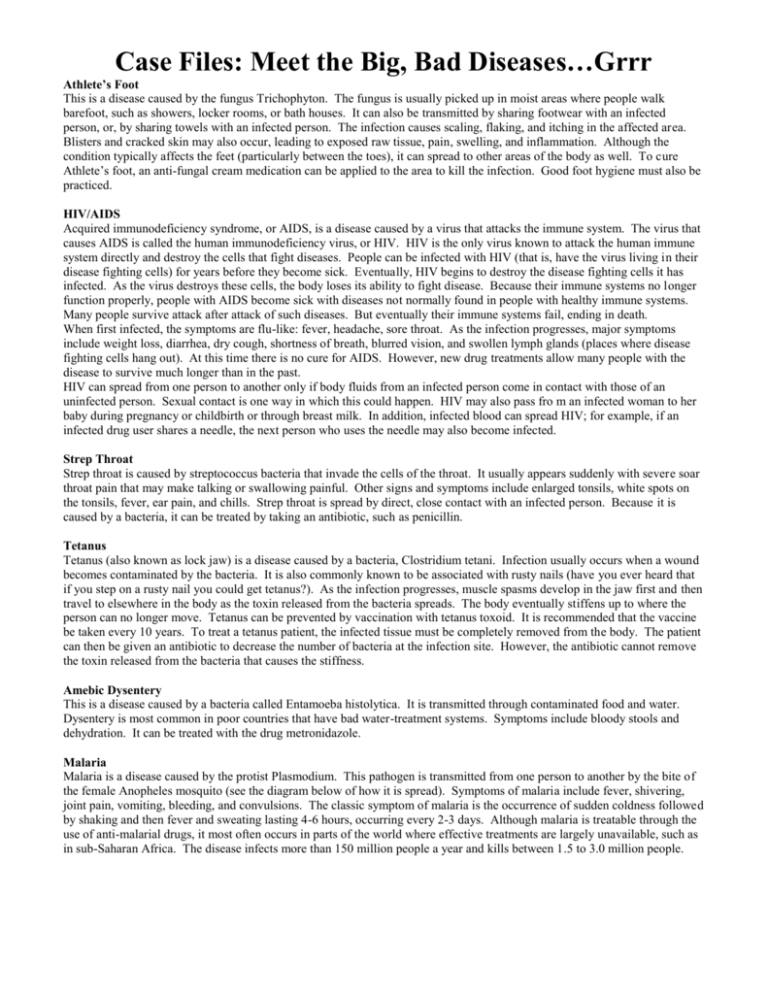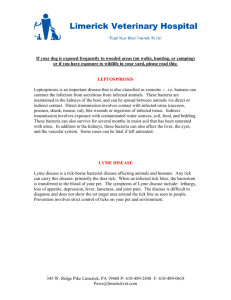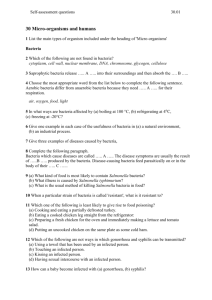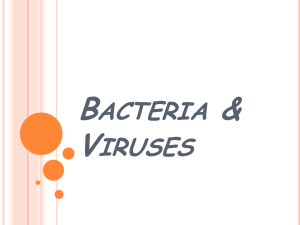Case Files: Meet the Big, Bad Diseases…Grrr
advertisement

Case Files: Meet the Big, Bad Diseases…Grrr Athlete’s Foot This is a disease caused by the fungus Trichophyton. The fungus is usually picked up in moist areas where people walk barefoot, such as showers, locker rooms, or bath houses. It can also be transmitted by sharing footwear with an infected person, or, by sharing towels with an infected person. The infection causes scaling, flaking, and itching in the affected area. Blisters and cracked skin may also occur, leading to exposed raw tissue, pain, swelling, and inflammation. Although the condition typically affects the feet (particularly between the toes), it can spread to other areas of the body as well. To cure Athlete’s foot, an anti-fungal cream medication can be applied to the area to kill the infection. Good foot hygiene must also be practiced. HIV/AIDS Acquired immunodeficiency syndrome, or AIDS, is a disease caused by a virus that attacks the immune system. The virus that causes AIDS is called the human immunodeficiency virus, or HIV. HIV is the only virus known to attack the human immune system directly and destroy the cells that fight diseases. People can be infected with HIV (that is, have the virus living in their disease fighting cells) for years before they become sick. Eventually, HIV begins to destroy the disease fighting cells it has infected. As the virus destroys these cells, the body loses its ability to fight disease. Because their immune systems no longer function properly, people with AIDS become sick with diseases not normally found in people with healthy immune systems. Many people survive attack after attack of such diseases. But eventually their immune systems fail, ending in death. When first infected, the symptoms are flu-like: fever, headache, sore throat. As the infection progresses, major symptoms include weight loss, diarrhea, dry cough, shortness of breath, blurred vision, and swollen lymph glands (places where disease fighting cells hang out). At this time there is no cure for AIDS. However, new drug treatments allow many people with the disease to survive much longer than in the past. HIV can spread from one person to another only if body fluids from an infected person come in contact with those of an uninfected person. Sexual contact is one way in which this could happen. HIV may also pass fro m an infected woman to her baby during pregnancy or childbirth or through breast milk. In addition, infected blood can spread HIV; for example, if an infected drug user shares a needle, the next person who uses the needle may also become infected. Strep Throat Strep throat is caused by streptococcus bacteria that invade the cells of the throat. It usually appears suddenly with severe soar throat pain that may make talking or swallowing painful. Other signs and symptoms include enlarged tonsils, white spots on the tonsils, fever, ear pain, and chills. Strep throat is spread by direct, close contact with an infected person. Because it is caused by a bacteria, it can be treated by taking an antibiotic, such as penicillin. Tetanus Tetanus (also known as lock jaw) is a disease caused by a bacteria, Clostridium tetani. Infection usually occurs when a wound becomes contaminated by the bacteria. It is also commonly known to be associated with rusty nails (have you ever heard that if you step on a rusty nail you could get tetanus?). As the infection progresses, muscle spasms develop in the jaw first and then travel to elsewhere in the body as the toxin released from the bacteria spreads. The body eventually stiffens up to where the person can no longer move. Tetanus can be prevented by vaccination with tetanus toxoid. It is recommended that the vaccine be taken every 10 years. To treat a tetanus patient, the infected tissue must be completely removed from the body. The patient can then be given an antibiotic to decrease the number of bacteria at the infection site. However, the antibiotic cannot remove the toxin released from the bacteria that causes the stiffness. Amebic Dysentery This is a disease caused by a bacteria called Entamoeba histolytica. It is transmitted through contaminated food and water. Dysentery is most common in poor countries that have bad water-treatment systems. Symptoms include bloody stools and dehydration. It can be treated with the drug metronidazole. Malaria Malaria is a disease caused by the protist Plasmodium. This pathogen is transmitted from one person to another by the bite of the female Anopheles mosquito (see the diagram below of how it is spread). Symptoms of malaria include fever, shivering, joint pain, vomiting, bleeding, and convulsions. The classic symptom of malaria is the occurrence of sudden coldness followed by shaking and then fever and sweating lasting 4-6 hours, occurring every 2-3 days. Although malaria is treatable through the use of anti-malarial drugs, it most often occurs in parts of the world where effective treatments are largely unavailable, such as in sub-Saharan Africa. The disease infects more than 150 million people a year and kills between 1.5 to 3.0 million people. Case Studies: Meet the Sad, Sickly Patients Case Study #1: Patient LeBron James Patient LeBron James went to his doctor because he was feeling sick after his recent trip to Africa. While he was there he accidentally consumed some of the local water. His biggest complaint is that when he goes #2 in the bathroom, his stools are bloody. LeBron has also been very thirsty lately. Case Study #2: Patient Kobe Bryant Patient Kobe Bryant lives in Los Angeles. He went to the hospital to receive treatment after spending one whole day in bed struck with recurring fevers that would last hours upon hours. He is now on day two of feeling sick and is still experiencing severe fevers and chills that last about 4 hours at a time. When the doctor came in to look at Kobe, he noticed that he had bumps from bites in multiple places on his body. Case Study #3: Patient Magic Johnson Patient Magic Johnson has been losing quite a bit of weight lately. As a basketball player he needs to keep his strength up, but no amount of food can keep him from gaining back weight. That’s why he came to see the doctor. His doctor noticed immediately that his lymph nodes were extremely swollen. Johnson also admitted on the background information of his patient information chart that he has had multiple sexual partners these past few years. Case Study #4: Patient Michael Jordan Patient Michael Jordan hasn’t been able to be on top of his superhero duties these past two days. First, the muscles in his jaw became very stiff. The stiffness has since spread to other muscles in his face. The doctor asked Michael about what he has been working on lately. Michael said that he has been rebuilding an old house that had rusty nails all over the floor. Case Study #5: Patient Will Smith Patient Will Smith recently finished his most recent movie. He has come to the doctor with the complaints of itchy, flaky feet. The doctor comments that at least Smith is wearing cool shoes to prevent him from continually scratching his feet. Smith responds saying that the shoes aren’t his and that he borrowed them from his wife Jada Pinkett Smith. Case Study #6: Patient James Bond Patient James Bond had ear problems as a child and has returned to the doctor with the complaint that his left ear is in pain once again. James is convinced that it’s a different kind of pain this time. In fact, his main other complain is that swallowing is painful because his tonsils are enlarged. The doctor immediately checks out James’ throat and finds that his tonsils have white spots all over them. Infectious Disease Case Study Lab Directions- You are a 4th year medical student about to earn your white coat and go on to graduate as a doctor! In order to graduate, you have to correctly diagnose a few patients. Read the description of each patient on the “Meet the Sad, Sickly Patients” handout, and then look at your case files on the “Meet the Big, Bad Diseases” handout to determine which disease each patient has. Then answer the questions below. REMEMBER…you are so close to becoming a doctor, so be sure to diagnose each patient correctly so that you can start earning the big bucks! Patient LeBron James: 1. What are patient LeBron James’ symptoms? 2. What disease do you think patient LeBron has? 3. What type of pathogen (bacteria, virus, protist, or fungus) infected him? 4. How do you think he got this disease? 5. Can you treat this patient? 6. If you can treat this patient, how would you do it (what drug would you give him)? 7. Because this disease is caused by a bacteria, what TYPE of drug helps kill diseases caused by bacteria? Patient Kobe Bryant: 1. What are patient Kobe Bryant’s symptoms? 2. What disease do you think patient Kobe Bryant has? 3. What type of pathogen (bacteria, virus, protist, or fungus) infected him? 4. How do you think he got this disease? 5. Can you treat this patient? If so, explain what drug you would use. Patient Magic Johnson: 1. What are patient Magic Johnson’s symptoms? 2. What disease do you think patient Magic Johnson has? 3. What type of pathogen (bacteria, virus, protist, or fungus) infected him? 4. How do you think he got this disease? 5. Can you treat this patient? Explain why or why not. Patient Michael Jordan: 1. What are patient Michael Jordan’s symptoms? 2. What disease do you think patient Michael has? 3. What type of pathogen (bacteria, virus, protist, or fungus) infected him? 4. How do you think he got this disease? 5. Can you treat this patient? If so, how? 6. To prevent future infection with this disease, what would you recommend Michael to do? Patient Will Smith 1. What are patient Will Smith’s symptoms? 2. What disease do you think patient Will Smith has? 3. What type of pathogen (bacteria, virus, protist, or fungus) infected him? 4. How do you think he got this disease? 5. Can you treat this patient? If you can treat this patient, how would you do it (what drug would you give him)? Patient James Bond: 1. What are patient James Bond’s symptoms? 2. What disease do you think patient James Bond has? 3. What type of pathogen (bacteria, virus, protist, or fungus) infected him? 4. How do you think he got this disease? 5. Can you treat this patient? If so, what drug would you give him? CONCLUSION QUESTIONS 1. Name the four types of pathogens that can infect the human body: ___________________, __________________, _________________, and ___________________ 2. Because all of the patients you diagnosed today were infected with a pathogen that made them sick, are these diseases considered infectious diseases or nonfectious diseases? 3. Antibiotics can be used to treat diseases caused by _______________________. 4. What is a vaccine? What is the purpose of getting a vaccine? What do vaccines do?








